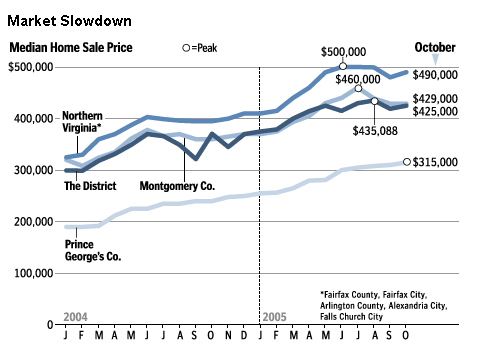Housing Bubble Bursts in D.C. Area
The long-predicted housing bubble may have finally burst in the D.C. metropolitan area, according to some recent trends. Or has it?
Housing Market Cooling, Data Say (WaPo, A1)
New data released yesterday show that in the past year, home sales in the Washington region have declined sharply, the inventory of unsold homes is up significantly, and prices have flattened and, in some cases, fallen.
The trend is most striking in Northern Virginia, where most of the region’s growth has occurred, but it is evident almost everywhere. Statistics on home sales released by Metropolitan Regional Information Systems Inc., the regional multiple-listing service, show that:
In the two counties and three cities that make up the Northern Virginia market, more than twice as many homes were available for sale in October as in the same month one year ago — 7,122 homes, compared with 3,254 — and sales are off 28 percent.
In the District, listings are up 62 percent and sales are down 28 percent.
In Montgomery County, listings are up 49 percent and sales are down 8 percent.
In Prince George’s County, the listings are up 45 percent. But home sales have remained fairly stable, dropping only 2.6 percent.
The last time the region had this many houses for sale was the late 1990s, the MRIS figures show .
With housing supply higher and demand lower, prices have fallen from their summertime peaks — though prices fluctuate every month and often decline in the fall because summer is the busiest home-buying season. Nevertheless, some slides are evident almost everywhere: In the District, the median price — the point at which half the houses cost more and half cost less — was $425,000 in October, down from a high in August of $435,088. In Fairfax County, the peak was in July, when the median price was $503,000; in October, it was $489,450. The peak in Montgomery County was also in July, when prices hit $460,000; the median price in October was $429,000.
The notable exception in the region was Prince George’s County, where October’s price was an all-time high of $315,000 — possibly because demand, spurred by prices that are still less expensive than elsewhere in the region, has remained high.
Interestingly, other recent stories indicated that summer was traditionally a period of slow sales in the area.
What’s ood here, though, is that the graph the accompanies the story seems to tell a different tale:

This would seem to show prices at near their all-time peak, experiencing only moderate fluctuations–and headed back upward. And that’s after increasing by nearly $100,000–25%–in the first five months of the year.
Housing experts say the slowdown is occurring for several reasons. In the past few months, a lot of homeowners put their places on the market speculatively, hoping to cash in, creating a surge in housing supply. Many investors, whether speculators or landlords, have done the same, either because they believe the market has peaked or because they cannot make enough money in rent to support the mortgages.
They are finding fewer buyers because the double-digit price appreciation of the past few years has priced many people out of the market. The recent rise in mortgage interest rates, which causes monthly payments to rise, adds to price pressures. And now, with fears that the market has peaked, more people are simply afraid to buy.
Meanwhile, new construction is inflating the housing supply, as condominium developers rush projects to market. According to a recent report by Delta Associates, 47,000 units in dozens of projects are hitting the local market in the next three years, which is about five times as many condo units as were sold last year.
So, there’s a bit of a glut on the market. That was the case when I was selling my townhouse in Ashburn in September. Instead of houses getting multiple offers the day they went on the market, it took a couple of weeks to get one offer. Instead of buyers bidding above the asking price, they made counteroffers. On the other hand, I still made a ridiculous profit after living in the place only two years.
The fact that builders are rapidly buying up old properties, razing them, and putting up new, more luxurious homes would seem to be an indication that they’re betting the market will continue to be robust. And that’s despite months of housing bubble talk from the press and the likes of outgoing Fed chairman Alan Greenspan, who also keeps jacking interest rates up to make affording a home more difficult.
Related:
-
Housing Bubble? What Housing Bubble?
Housing Bubble in D.C. Area Bursting?
Housing Bubble a Trillion-Dollar Bet
The Housing Bubble and Government Spending
Interest Only Mortgages ‘Risky’
Housing Bubble Versus Tech Bubble
Housing Bubbles and Rent Ratios
Real Estate Bubble Economy?
The Housing Bubble?





Heh, they just assume that everyone is going to want their home to close around December 20th-30th and having the moving trucks outside to relocated during the Holidays.
Duh.